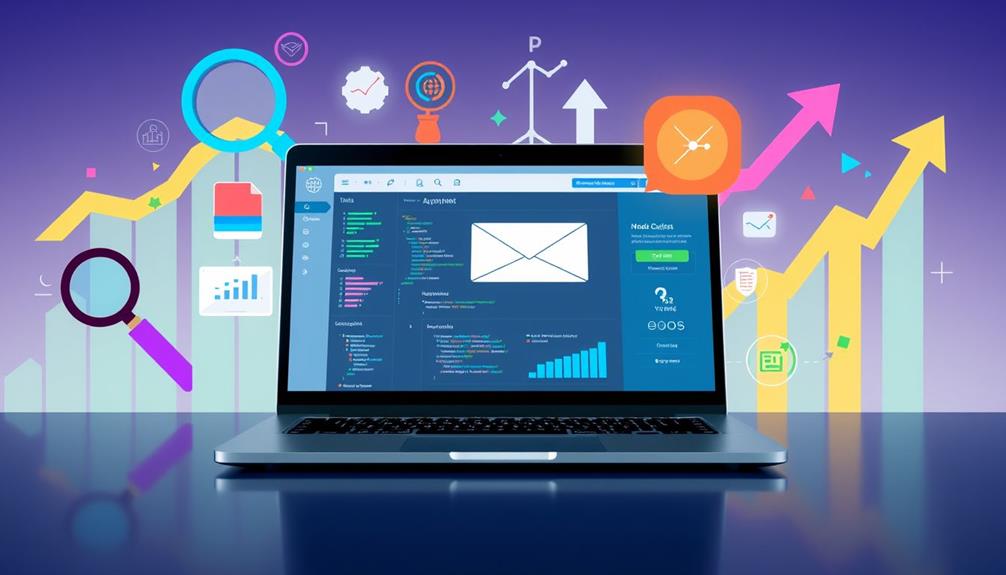Email marketing serves as an influential means for companies to directly interact and engage with their audience. Nonetheless, it comes with its set of challenges. Surprisingly, a whopping 59% of marketers identify email marketing as their foremost challenge. Indeed, you heard correctly – the majority of marketers encounter hurdles that can detract from the success of their email marketing efforts.
In this article, we will delve into the top 5 toughest challenges in email marketing and provide practical solutions to overcome them. By addressing these challenges head-on, you can elevate your email marketing game and achieve better results. Let’s dive in!
Key Takeaways:
- Understanding and overcoming the challenges of email marketing is crucial for success.
- Avoiding spam filters, capturing recipients’ attention, and creating convenience are key challenges to address.
- Increasing click-through rates, effectively using generative AI, and leveraging user data are essential for improved email marketing.
- Improving email deliverability, retaining subscribers, and enhancing click-through rates contribute to long-term success.
- By implementing the right strategies and staying informed, you can navigate the challenges of email marketing and achieve your goals.
Challenge 1 – Avoiding Spam Filters
One of the biggest challenges in email marketing is avoiding spam filters. Email service providers use algorithms to determine whether an email should be delivered to the recipient’s inbox or marked as spam. Marketers can overcome this challenge by increasing engagement and sending relevant and personalized emails. By understanding their customers’ interests and needs, marketers can create valuable content that will avoid the spam filter and increase engagement with their emails.
Spam filters are designed to protect users from unwanted and unsolicited emails, but they can sometimes misclassify legitimate emails as spam. To ensure that your emails reach the recipients’ inbox, it is crucial to focus on email deliverability. By following best practices and implementing the following strategies, you can improve your email deliverability and increase the chances of your emails being seen by your target audience.
- Build a quality email list: Ensure that you have permission to email the recipients on your list. Avoid purchasing email lists or adding email addresses without explicit consent. Removing invalid and inactive email addresses regularly will also improve your email deliverability.
- Send relevant and personalized emails: Tailor your email content to match the interests and preferences of your subscribers. Personalization can significantly increase engagement and help your emails avoid spam filters.
- Optimize your subject lines: Craft compelling subject lines that are not misleading or spammy. Avoid using excessive capitalization, excessive punctuation, or words/phrases commonly associated with spam.
- Use a reputable email service provider: Choose an email service provider with a good reputation for deliverability. They will have established relationships with ISPs and a track record of high deliverability rates.
- Monitor your email metrics: Keep an eye on your email open rates, click-through rates, and spam complaints. Monitoring these metrics will help you identify any issues and make necessary adjustments to improve your email deliverability.
By implementing these strategies, you can increase your email deliverability and ensure that your emails reach the right audience. Remember to regularly review and update your email marketing practices to stay ahead of any changes in spam filter algorithms and maintain a high level of engagement with your subscribers.
Challenge 2 – Getting Recipients’ Attention
With the average person receiving numerous marketing emails daily, getting recipients’ attention is a significant challenge in email marketing. In order to improve email open rates and stand out in the inbox, we employ two effective strategies: optimizing subject lines and personalization.
Optimizing subject lines:
Subject lines are the first thing recipients see when scrolling through their inbox. To capture their attention, it’s important to create concise and eye-catching subject lines that pique their curiosity. By using powerful and engaging words, asking questions, or teasing valuable content, we can entice recipients to open the email and discover what’s inside. Additionally, it’s crucial to avoid using spam trigger words to prevent emails from being flagged as spam and ensure they reach recipients’ inboxes.
Personalization:
Personalizing emails adds a touch of relevance and makes recipients feel valued. By addressing recipients by their names, we create a sense of familiarity and establish a connection. Knowing your audience is key when personalizing emails. By sending emails based on recipients’ preferences, interests, and previous interactions with your brand, you can provide content that is highly relevant to them. Whether it’s tailored product recommendations, exclusive offers, or personalized event invitations, personalization helps you stand out and increases the likelihood of recipients opening and engaging with your emails.
Incorporating these strategies into your email marketing campaigns can have a significant impact on improving email open rates and grabbing recipients’ attention. Let’s take a look at an example of how optimizing subject lines and personalization can make a difference:
“Hey {Recipient’s Name}, Don’t Miss Out on Our Limited-Time Offer!”
In the example above, we can see how addressing the recipient by their name and mentioning a limited-time offer in a concise and attention-grabbing way can entice them to open the email and explore the offer further.

| Challenge | Strategy |
|---|---|
| Getting Recipients’ Attention |
|
| Result | Improved email open rates and increased engagement |
Challenge 3 – Creating Convenience
In the world of email marketing, convenience is key. One of the challenges we often face as marketers is getting recipients to take action, such as filling out forms. However, we have a solution to simplify these actions and make the process easier for both marketers and recipients.
Introducing one-click emails! With one-click emails, recipients can complete actions with just a single click, reducing the friction involved in signing up for offers and engaging with email content.
Let’s take a closer look at how one-click emails can help streamline the process:
| Challenge | Solution |
|---|---|
| Email list management | One-click emails eliminate the need for recipients to manually enter their personal information, making it quicker and easier to sign up and join your email list. |
| Simplifying actions in emails | By simplifying actions to just one click, recipients can easily engage with your email content without the hassle of complex steps or forms. |
| One-click emails | Recipients no longer need to spend time filling out forms or providing their information repeatedly. With one click, they can complete the desired action effortlessly. |
By implementing one-click emails, you can significantly improve the user experience and increase the likelihood of recipients taking the desired actions. With a simplified process, you remove barriers and make it more convenient for recipients to engage with your email campaigns.

Challenge 4 – Increasing Click-through Rates
One of the persistent challenges in email marketing is improving click-through rates. In a world where recipients quickly skim through their emails, it’s crucial to grab their attention and inspire them to take action. To overcome this challenge, we employ strategies that focus on keeping emails concise, reducing confusion, and using postscripts to maximize engagement.
Keeping Emails Concise
When it comes to email marketing, less is often more. Recipients appreciate messages that get straight to the point without unnecessary fluff. By crafting concise emails, we can deliver our message effectively and increase the chances of recipients engaging with the content. We avoid overwhelming them with lengthy paragraphs and instead focus on presenting our information in a clear and concise manner.
Single Call to Action
Providing recipients with multiple options can lead to decision paralysis and reduce click-through rates. To alleviate this challenge, we incorporate a single call to action (CTA) in our emails. This strategy guides recipients towards a specific action, reducing confusion and increasing the likelihood of them clicking on the desired link.
Postscripts: A Powerful Tool
Postscripts provide a valuable opportunity to capture recipients’ attention and motivate them to take action. By adding a short additional message at the end of the email, we can pique curiosity and increase the likelihood of click-throughs. Postscripts act as a subtle nudge that encourages recipients to revisit the email and explore further.
“By following a concise email structure and utilizing a single call to action, we significantly boost click-through rates. Additionally, incorporating a postscript at the end of the email serves as a compelling tool to captivate recipients and drive engagement.”
To summarize, increasing click-through rates in email marketing can be achieved through concise and focused emails, single call to action strategies, and the strategic use of postscripts. By implementing these strategies, we can effectively capture recipients’ attention and drive them towards taking the desired action.

Challenge 5 – Using Generative AI Effectively
As email marketing embraces the power of generative AI, we are faced with the challenge of effectively utilizing this technology. While generative AI has the potential to create personalized content, it can also generate formulaic and unnatural messaging. To overcome this hurdle, we must prioritize content editing to refine AI-generated content and eliminate any formulaic or repetitive language.
By carefully reviewing and editing the AI-generated content, we can ensure that it aligns with our brand’s unique voice and resonates with our audience. This is particularly important in email marketing, where personalized and authentic communication is key. Eliminating formulaic language will create a more engaging and human-like experience for our subscribers.
Generative AI opens up exciting possibilities for content ideation and repurposing existing materials. By leveraging this technology, we can enhance our email marketing campaigns with fresh and innovative ideas.
Content Editing: Striking the Right Balance
Effective content editing with generative AI involves striking the right balance between human creativity and AI assistance. While the technology can generate content, it is our role as marketers to refine and optimize it. Through content editing, we can ensure that the AI-generated content aligns with our goals, brand identity, and the preferences of our subscribers.
Content editing includes reviewing and refining the tone, style, and messaging of the AI-generated content. By injecting our unique brand personality into the content, we can deliver a more personalized and relatable experience to our subscribers. It is important to eliminate any generic or robotic language that may be present in the AI-generated content to maintain a genuine and human touch.
Pros and Cons of Using Generative AI in Email Marketing
| Pros | Cons |
|---|---|
| 1. Enables personalized content creation | 1. May generate formulaic or unnatural content |
| 2. Enhances content ideation and innovation | 2. Requires careful editing and refinement |
| 3. Increases efficiency in content production | 3. Potential risk of losing brand uniqueness |
| 4. Provides opportunities for content repurposing | 4. Requires monitoring for proper context and relevance |

When effectively used, generative AI can inspire creativity, save time, and enhance our email marketing campaigns. By leveraging its power, we can create personalized content that resonates with our subscribers on a deeper level. However, content editing is crucial to refine the AI-generated content and ensure that it aligns with our brand identity and engages our audience.
The Future of Email Marketing
While email marketing continues to be an effective marketing channel, the future of email marketing will be heavily influenced by advancements in AI and automation. As consumers’ expectations for convenience and relevance continue to rise, marketers face increasing pressure to deliver highly personalized and convenient email experiences. To stay competitive in the ever-evolving email marketing landscape, it is crucial for marketers to stay up to date with spam filter algorithms, emerging technologies like generative AI, and industry trends.
Email marketing has come a long way since its inception. In the early days, marketers would send bulk emails to a generic list of recipients, hoping for the best. However, with the advancements in AI and automation, email marketing has become more sophisticated and personalized. Marketers now have access to powerful tools and technologies that enable them to create targeted and personalized email campaigns that resonate with their audience.
The relevance and convenience of email marketing are key factors that will shape its future. Customers are increasingly demanding personalized experiences, and email marketing is no exception. Marketers must leverage AI and automation to deliver hyper-personalized emails that speak directly to the recipient’s needs and interests. By analyzing customer data and leveraging AI algorithms, marketers can create customized content that not only captures attention but also drives engagement and conversions.
Furthermore, advancements in AI-powered automation allow marketers to streamline their email marketing efforts and deliver timely and relevant messages. With automation, marketers can set up triggered emails based on specific customer actions or events, such as abandoned cart reminders or birthday greetings. This not only saves time and resources but also ensures that customers receive the right message at the right time, enhancing their overall experience.
The email marketing landscape is continuously evolving, and marketers need to stay ahead of the curve to remain competitive. In addition to keeping up with emerging technologies and industry trends, it is crucial to regularly evaluate and optimize email marketing strategies. By closely monitoring performance metrics, testing different approaches, and optimizing campaigns based on data-driven insights, marketers can maximize the effectiveness of their email marketing efforts.
The Impact of AI and Automation on Email Marketing
AI and automation have revolutionized email marketing, enabling marketers to deliver highly personalized and convenient experiences to their audience. With AI-powered algorithms, marketers can analyze customer data, segment their email lists, and create personalized content that resonates with each individual recipient. Automation allows for timely and relevant messaging, ensuring that customers receive the right message at the right time. Together, AI and automation are shaping the future of email marketing, empowering marketers to deliver exceptional results and drive business growth.
The Role of Relevance and Convenience
Relevance and convenience are two crucial factors that will shape the future of email marketing. Customers are inundated with emails on a daily basis, and standing out in the crowded inbox requires delivering highly relevant and convenient experiences. Marketers must focus on providing value to their subscribers by sending personalized content that meets their specific needs and interests. Additionally, making interactions as convenient as possible, such as using one-click actions or providing relevant recommendations, can enhance the overall email experience.
Keeping Up with Spam Filter Algorithms
Spam filters play a crucial role in determining the deliverability of email marketing campaigns. As spam filter algorithms become more sophisticated, marketers must stay vigilant to ensure their emails reach the intended recipients’ inboxes. This includes following best practices for email deliverability, such as maintaining a good email reputation, avoiding spam-trigger words, and adhering to email formatting guidelines. Staying informed about the latest developments in spam filter algorithms and adjusting email marketing strategies accordingly is essential to maintaining high deliverability rates.
The Ever-Evolving Email Marketing Landscape
| Email Marketing Landscape | Advancements in AI and Automation | Relevance and Convenience |
|---|---|---|
| Increased competition | Personalized email experiences | Delivering value to subscribers |
| Rising customer expectations | AI-powered segmentation | Convenient interactions |
| Evolving spam filters | Automated email workflows | Optimized email content |

<!—->
The Importance of List Segmentation
List segmentation plays a vital role in overcoming the challenges of email marketing. By segmenting our email lists based on customer attributes, we can send targeted and personalized emails to specific segments of our audience. This allows us to deliver content that is relevant and tailored to each segment’s interests and preferences.
Targeted emails have a higher chance of resonating with recipients and driving engagement. When we send emails that are specifically designed for a particular segment, we can address their unique needs and pain points, making them more likely to open, click, and convert.
Customer segmentation is a strategic approach that divides our email list into distinct groups based on various factors such as purchase status, customer lifetime value, and product affinity. By understanding our customers better and grouping them accordingly, we can create more effective email campaigns that generate higher ROI.
The Benefits of List Segmentation
Effective list segmentation offers several benefits, including:
- Personalized Content: By segmenting our email list, we can create targeted content that resonates with each group. This personalized approach enhances the customer experience and boosts engagement.
- Improved Open Rates: When we send emails that are highly relevant to a specific segment, recipients are more likely to open them, leading to higher open rates.
- Increased Click-through Rates: Targeted emails tend to have higher click-through rates as they are designed to address the specific interests and pain points of each segment.
- Better Customer Satisfaction: By delivering content that aligns with the interests and preferences of each segment, we enhance the overall customer experience, leading to higher customer satisfaction and loyalty.
List segmentation allows us to maximize the potential of our email marketing campaigns. By tailoring our content to the unique needs of each segment, we can achieve better results and drive meaningful interactions with our audience.
“By segmenting our email lists, we can deliver highly relevant content that resonates with our subscribers, ultimately leading to higher engagement and conversions.”
| List Segmentation Factors | Description |
|---|---|
| Purchase Status | Dividing our list based on whether subscribers are current customers, past customers, or potential customers. |
| Customer Lifetime Value | Creating segments based on the value customers bring to our business, allowing us to tailor our messaging and offers accordingly. |
| Product Affinity | Segmenting our list based on the specific products or categories that subscribers have shown interest in or purchased. |
Segmenting our email lists enables us to send targeted emails, deliver personalized content, and achieve better results in our email marketing campaigns. By understanding the importance of list segmentation, we can maximize the effectiveness of our email marketing efforts and drive success in our overall marketing strategy.

The Key to Customer Retention
Customer retention is essential in email marketing. As marketers, our goal is to not only acquire new customers but also keep existing ones. Investing in customer retention is cost-effective and can lead to long-term business success. To achieve this, we need to focus on delivering personalized and interactive content that engages our customers and keeps them coming back for more.
Personalization is a powerful tool that allows us to tailor our emails to each customer’s specific interests and preferences. By analyzing customer data and understanding their on-site behavior, we can create email content that is relevant and compelling. For example, we can use geolocation to offer location-based promotions or weather-based offers to cater to customers’ immediate needs and interests.
Interactive content is another effective way to engage customers and increase their retention. By incorporating features such as interactive polls, surveys, or quizzes, we can create a two-way communication channel that encourages customer engagement. This not only provides valuable insights but also makes the email experience more enjoyable and memorable for our customers.
Additionally, loyalty programs play a crucial role in customer retention. By offering exclusive rewards, discounts, or VIP benefits, we can incentivize customers to stay loyal to our brand. Loyalty programs create a sense of belonging and appreciation, making customers feel valued and motivated to continue their relationship with us.
By delivering personalized and interactive content and implementing loyalty programs, we can enhance customer retention and drive repeat purchases. It’s not just about acquiring new customers but also nurturing and strengthening our relationship with existing ones.
Let’s take a look at the table below, which highlights the impact of personalized and interactive content on customer retention:
| Retention Strategy | Benefits |
|---|---|
| Personalization | – Increased customer engagement – Higher open and click-through rates – Improved conversion rates |
| Interactive Content | – Enhanced customer experience – Increased brand loyalty – Valuable customer insights |
| Loyalty Programs | – Increased customer retention – Repeat purchases – Word-of-mouth referrals |
As we can see, implementing personalized and interactive content along with loyalty programs can have significant benefits for customer retention. It’s important to continuously analyze customer data, monitor engagement metrics, and optimize our strategies to ensure we are providing the best possible experience for our customers.
Now, let’s explore how we can leverage user data to personalize our email content in the next section.

Leveraging User Data for Personalization
User data is a goldmine for email marketing personalization. By connecting our email marketing software with online stores, we can gather valuable insights into customer purchase history and online activity. This data allows us to create highly personalized email content that resonates with customers on a deeper level.
When we have access to customer insights, we can tailor our email content to match their preferences and behavior. For example, by analyzing their purchase history, we can offer personalized discounts or recommendations based on their previous purchases. This level of personalization makes customers feel valued and strengthens their connection with our brand.
Data integration is a crucial aspect of leveraging user data for personalization. By integrating and analyzing customer data from various sources, we can gain a comprehensive understanding of our customers and make informed decisions about our personalization strategies. This integration allows us to deliver targeted and relevant content to each customer segment, improving the effectiveness of our email marketing campaigns.
“Personalization is not just a nice-to-have; it’s a must-have for successful email marketing. By leveraging user data, we can create tailored experiences that engage our customers and drive conversions.”
The Power of Personalization
Personalized emails have shown significant improvements in key metrics such as open rates, click-through rates, and conversions. According to a study by Epsilon, personalized emails deliver six times higher transaction rates compared to generic emails. By leveraging user data, we can tap into the power of personalization and drive better results for our email marketing campaigns.
Benefits of Leveraging User Data for Personalization:
- Increased customer engagement and loyalty
- Improved email open rates and click-through rates
- Higher conversion rates and revenue
- Enhanced customer satisfaction and brand perception
By harnessing the power of user data and integrating it effectively into our email marketing strategies, we can deliver personalized experiences that truly resonate with our customers’ needs and preferences. The result? A strong and lasting relationship with our audience that drives business growth.

Improving Email Deliverability
Email deliverability is a key concern for email marketers. To ensure that our emails reach the intended recipients’ inbox, there are several best practices we follow:
- Optimizing Subject Lines: We understand the importance of subject lines in grabbing recipients’ attention and avoiding spam filters. By crafting concise and compelling subject lines that accurately represent the email content, we increase the chances of our emails being delivered.
- Avoiding Spam Trigger Words: We steer clear of using spam trigger words that can trigger spam filters and prevent our emails from reaching the inbox. Instead, we focus on using words that are relevant to the email content and resonate with our audience.
- Maintaining a Good Email Reputation: We prioritize maintaining a good email reputation by adhering to email industry standards and guidelines. By sending relevant and engaging content to our subscribers, we enhance their overall email experience and build a positive reputation.
- Proper Email Formatting: We ensure that our emails are properly formatted to improve deliverability. This includes using HTML and CSS appropriately, optimizing images, and structuring the email content in a user-friendly manner.
- Avoiding Spammy Practices: We avoid engaging in spammy practices such as buying email lists or sending unsolicited emails. By focusing on building a qualified and engaged subscriber base, we increase the chances of our emails being delivered.
- Cleaning up Email Lists: Regularly cleaning up our email lists is crucial for maintaining deliverability. We remove inactive or unengaged subscribers, update email addresses, and correct any invalid or bounced email addresses.
Following these best practices and actively managing email deliverability allows us to improve the chances of our emails reaching our audience. By ensuring that our emails avoid spam filters and maintain a good email reputation, we can effectively deliver our message and achieve our email marketing goals.
Retaining Subscribers for Long-term Success
Retaining subscribers is crucial for the long-term success of our email marketing campaigns. To achieve this, we focus on sending relevant and valuable content to engage our subscribers and keep them interested in future emails. By implementing email segmentation, evaluating our content strategy, and optimizing the timing of our emails, we can greatly improve our subscriber retention rates.
One effective strategy is to provide a mix of informational, social, and promotional content to cater to different subscriber interests. By offering a variety of content types, we ensure that our emails remain engaging and valuable to our subscribers. This can include industry updates, helpful resources, entertaining content, and exclusive offers.
Additionally, allowing subscribers to control the frequency of our emails is important in maintaining their engagement. By giving them the option to choose how often they receive emails, we respect their preferences and ensure that our messages don’t become overwhelming or irrelevant. This level of customization enhances the subscriber experience and fosters a stronger connection with our brand.
Benefits of Relevant Content and Optimal Timing
Delivering relevant content is key to maintaining a strong subscriber base. When our subscribers consistently find value in our emails, they are more likely to stay engaged and continue opening our messages. To ensure content relevance, we utilize data-driven insights and segmentation techniques. By analyzing subscriber preferences, purchase history, and engagement patterns, we tailor our emails to deliver personalized content that resonates with each individual subscriber.
| Benefits of Relevant Content: | Benefits of Optimal Timing: |
|---|---|
|
|
Furthermore, optimizing the timing of our emails is essential in capturing our subscribers’ attention. By analyzing engagement patterns and considering factors such as time zones and demographics, we send our emails at the most opportune moments. This ensures that our messages are seen when our subscribers are most likely to be receptive, resulting in higher open and click-through rates.
The Power of Engagement Rates
“Engagement rates are a crucial metric that reflects the effectiveness of our email campaigns. By focusing on subscriber retention and delivering relevant content, we can boost engagement rates and develop strong relationships with our audience.”
Engagement rates are a valuable measure of how our subscribers interact with our emails. By monitoring and analyzing these rates, we gain insights into the effectiveness of our email campaigns and can make data-driven improvements. High engagement rates indicate that our subscribers find value in our content and are actively interacting with our brand. This, in turn, increases the likelihood of conversions, customer loyalty, and long-term success.
To improve engagement rates, we continuously evaluate our content strategy, making adjustments to align with our subscribers’ evolving preferences. Additionally, employing interactive elements such as surveys, polls, and social media shares can encourage active participation and further enhance engagement rates.

By focusing on retaining our subscribers through relevant content, frequency and relevance customization, and optimizing our email timing, we can forge stronger connections with our audience, increase engagement rates, and reduce unsubscribe rates. This sustained engagement with our subscribers not only leads to better email marketing success but also fosters a loyal base of customers who are more likely to become advocates for our brand.
Improving Email Click-through Rates
Click-through rates are a crucial metric for measuring the success of email marketing campaigns. As marketers, we strive to create compelling content that encourages our subscribers to take action. In this section, we will discuss key strategies to improve email click-through rates and maximize the effectiveness of our email marketing efforts.
Incorporate Engaging Video Content
One effective way to boost click-through rates is by incorporating video content into our emails. Videos are visually engaging and can convey information in a concise and captivating way. With attention spans becoming shorter, videos have the power to instantly grab our subscribers’ attention and encourage them to click on our desired call-to-action.

Enhance Subscriber Engagement
In addition to video content, there are other elements we can leverage to increase subscriber engagement and drive more clicks. By using eye-catching images, relevant polls, and social share links, we can create a compelling email that piques our subscribers’ interest. Encouraging them to interact with our content fosters a stronger connection and can lead to higher click-through rates.
Optimize for Mobile Devices
With the increasing use of smartphones, it’s crucial to optimize our emails for mobile devices. A mobile-responsive design ensures that our emails are readable and load quickly on smaller screens, providing a seamless user experience. By optimizing for mobile, we remove any barriers that may hinder click-through rates and ensure that our subscribers can easily engage with our content.
| Strategies | Benefits |
|---|---|
| Incorporate video content | Increased engagement and click-through rates |
| Use eye-catching images, polls, and social share links | Enhanced subscriber interest and interaction |
| Optimize emails for mobile devices | Improved readability and user experience |
By implementing these strategies, we can effectively improve email click-through rates and maximize our subscriber response. Remember, it’s essential to continuously monitor and analyze the performance of our emails to identify trends and make data-driven improvements. Let’s stay ahead of the curve and create email marketing campaigns that truly resonate with our audience.
Conclusion
Overcoming the challenges of email marketing is key to achieving success in this highly effective marketing channel. By implementing the right strategies, we can enhance our email marketing campaigns and maximize results. We have explored various challenges and their solutions, focusing on avoiding spam filters, capturing recipients’ attention, creating convenience, increasing click-through rates, and effectively using generative AI.
Leveraging user data, improving email deliverability, retaining subscribers, and improving click-through rates are also crucial for long-term email marketing success. By analyzing customer insights, personalizing content, and integrating data, we can create targeted and relevant emails that engage subscribers and drive conversion. Additionally, maintaining a good email reputation and ensuring proper email formatting contribute to better deliverability rates.
In order to navigate the challenges of email marketing and achieve our goals, it is important to stay informed about industry trends and advancements. By keeping up with emerging technologies and best practices, we can continue to deliver highly personalized and convenient email experiences that meet the expectations of our audience. With a strategic approach and continuous improvement, we can overcome challenges and unlock the full potential of email marketing.
FAQ
What are the top 5 email marketing challenges?
The top 5 email marketing challenges include avoiding spam filters, getting recipients’ attention, creating convenience, increasing click-through rates, and using generative AI effectively.
How can I avoid spam filters in email marketing?
To avoid spam filters, increase engagement by sending relevant and personalized emails. Understand your customers’ interests and create valuable content to avoid the spam filter.
How can I get recipients’ attention in email marketing?
Optimize subject lines, personalize emails, and use concise and eye-catching language to grab recipients’ attention. Address recipients by their names and send emails based on their preferences and interests.
How can I create convenience in email marketing?
Simplify actions in emails by using one-click emails. This allows recipients to transfer personal information with a single click, making it easier for them to sign up for offers and engage with the email content.
How can I increase click-through rates in email marketing?
Keep emails concise and focused with only one clear call to action. Add a postscript at the end of the email to grab recipients’ attention. These strategies can improve click-through rates and encourage recipients to click on desired links.
How can I use generative AI effectively in email marketing?
Edit AI-generated content to remove any formulaic or repetitive language. Leverage generative AI for content ideation and repurposing existing content to enhance your email marketing campaigns.
What is the future of email marketing?
Advancements in AI and automation will shape the future of email marketing. Relevance and convenience will be key as consumers’ expectations rise, requiring marketers to deliver highly personalized and convenient email experiences.
Why is list segmentation important in email marketing?
List segmentation allows marketers to send targeted and personalized emails to specific segments of their audience. This increases the relevance and effectiveness of the emails and leads to higher open rates, click-through rates, and engagement.
How can I improve customer retention in email marketing?
Focus on delivering personalized and interactive content to engage subscribers. Tailor emails to customers’ specific interests and behaviors to grab their attention and keep them interested in future emails.
How can I leverage user data for email marketing personalization?
Connect your email marketing software with your online store to gain valuable insights into customer purchase history and online activity. Use this data to personalize email content, such as offering personalized discounts or recommendations based on customer behavior.
How can I improve email deliverability?
Avoid spam filters by optimizing subject lines, avoiding spam trigger words, and maintaining a good email reputation. Properly format emails, avoid spammy practices, and regularly clean up email lists to contribute to better deliverability.
How can I retain subscribers for long-term success in email marketing?
Send relevant and valuable content to engage subscribers and keep them interested in future emails. Implement email segmentation, evaluate your content strategy, and optimize email timing to improve subscriber retention rates.
How can I improve email click-through rates?
Incorporate video content into your emails to make them more engaging. Use images, polls, and social share links to enhance subscriber engagement and encourage clicks. Ensure that your emails are mobile-responsive for higher click-through rates.
What are the solutions to the challenges in email marketing?
By implementing strategies such as increasing engagement, optimizing subject lines, simplifying actions, keeping emails concise, and effectively using generative AI, marketers can overcome the challenges in email marketing and achieve success.










